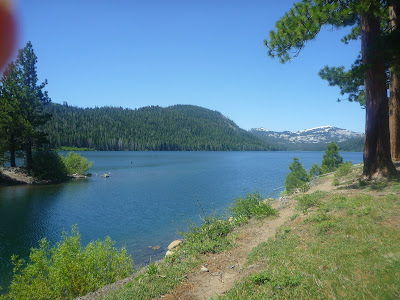 |
| North Shore Trail at Independence Lake with the Sierra Crest far back, still showing patches of snow at the end of June |
Independence Lake is a pristine glacial lake in the Sierra Nevada north of Truckee, California. The lake is known as the jewel of the Sierra. The preserve invites you for lake-side picnicking, hiking, mountain biking, kayaking, bird watching and fishing. The lake is home to one of only two wild, self-sustaining lake populations of Lahontan cutthroat trout (LCT) in the world. In addition to LCT, Independence Lake hosts populations of six other native Lahontan fishes that have lived here since glaciers disappeared some 10,000 years ago [1].
 |
| Kayakers in the middle of Independence Lake |
Independence Lake is 2.4 miles long and half a mile wide with a maximum depth of 145 feet (44.2 m). Its surface elevation is 6,949 feet (2,118 m) [2]. The North Shore Trail is a 2.7 mile-long trail alongside the lake's north shore. You will find some picnic areas along the beginning section of the trail. This is a forest trail, but you will chance upon multiple spots to access refreshing lake water—with magnificent views everywhere. Even by early summer, it is not uncommon here to find snow plants (Sarcodes sanguinea) in the shade of conifers.
 |
| Snow plants next to North Shore Trail (June 29, 2025) |
Although there is a North Shore Trail and a South Shore Trail, a round trip around the lake is currently not advised (as long as no bridge has been built). Both shore trails end at the southwest tip of the lake, where the Upper Independence Creek meets the lake water. This creek may be difficult to cross and the Nature Conservancy asks hikers and mount bikers to stay away from this part of the lake between May 1 and August 31 to avoid disturbing spawning of LCT in Upper Independence Creek .
 |
| North Shore Trail turnaround point during LCT spawning season |
Independence Lake Trail Map
 |
| Map with North Shore Trail, South Shore Trail and South Ridge Trail |
All lake area trails—North Shore Trail, South Shore Trail, and South Ridge Trail—are dead-ends, of about the same length (2.5 to 3.0 miles).
References & Suggested Browsing
[1] Independence Lake Preserve. URL: https://www.nature.org/en-us/get-involved/how-to-help/places-we-protect/independence-lake/.
[2] Judy DePuy / Truckee-Donner Historical Society. History: The Survival of Independence Lake: Part 1. URL: https://www.sierrasun.com/news/history-the-survival-of-independence-lake-part-1/.
















































